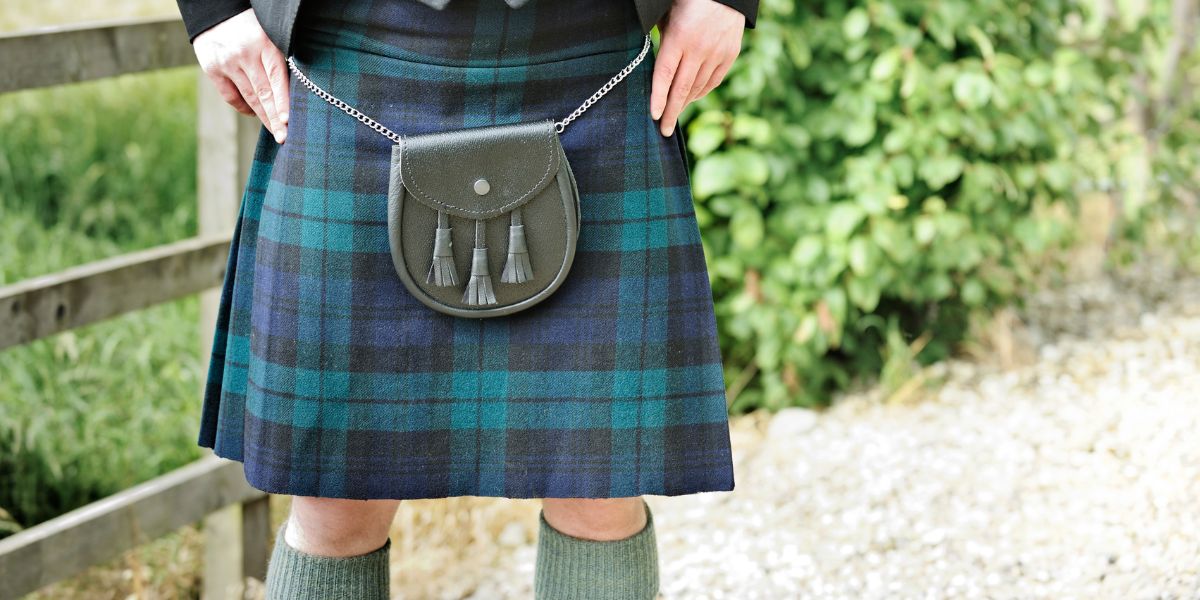Yes, you can wash a kilt! But special care is needed for this delicate wool garment. Let’s look at the best way to clean your kilt so it can be worn for decades to come.
For those outside Scotland, it’s a common misconception that all Scots wear their kilts on a daily basis, going about their lives strolling the Highlands and chasing after those elusive haggis!
The truth is many Scots do not even own a kilt – they are only really worn for weddings and, even then, just hired for the weekend. However, most grooms on their wedding day will opt to purchase their own kilt. It’s seen as a good investment as it can be worn again for other special occasions, saving money on future hires.
Needless to say, Scottish weddings can become a little wild later on at night once the whisky gets flowing and kilts can suffer from spillages… and if worn as a “true Scotsman“, they can get dirty in other ways too…ahem.
Key information on cleaning a Scottish kilt:
Cleaning your Kilt – Hand Washing
Hand Wash Only!
Hand washing is by far the best way to wash your high-quality wool kilt, preserving the delicate pleats and causing no damage to the fabric.
Check the care label on your kilt
Firstly, check the label on your kilt. If your kilt is handmade, it may not have a label; if this is the case, check with your kilt maker for the best way to clean your kilt. If the instruction label recommends professional cleaning only, your kilt may be made from special materials (for example, a rare type of wool) which will require specialist cleaning.
Only use cold water on your kilt
Start with a basin of cold water. Hot water may cause your kilt to shrink or the colours to run. Try to find a very mild detergent and mix it with the cold water in a large basin.
Submerge your kilt completely in the cold water, taking care not to twist or wring the fabric. You want to maintain the shape of the kilt and the pleats.
Wash your kilt with your hands
Gently agitate the detergent-infused water with your hands over the kilt, helping it to penetrate into the fibres. Again, work very gently, being careful not to misshape the kilt or rub too hard on the fabric. Without sounding too coarse, if you wear nothing under your kilt, take special care to wash the area that rubs against your private areas!
Soak the kilt
After a first pass of hand washing the kilt, leave the kilt to soak in the water for up to 30 minutes to loosen any existing dirt/grime. After 30 minutes, inspect the kilt for any areas that may need more gentle washing to clean.
Rinse your kilt
Using cold water, rinse the kilt and remove as much soap as possible. Again, fill the basin with cold, clean water, with no detergent this time, and resubmerge the kilt. Using your hands, gently agitate the fabric of the kilt to remove the soap. Empty the basin and refill it with cold, clean water; repeat this process until your kilt runs clear free of soap suds.
Press out the water
Empty the water from your basin, then put the soaking wet kilt back into the empty basin. Gently press the kilt against the sides of the basin, removing a little water each time, and empty the basin when water collects. Make sure to use a gentle pressing action and do not wring or twist out the water, as you will cause damage to the fabric or distort the kilt’s shape.
Dry the kilt on a flat surface
Your kilt will likely still be quite wet after you have pressed it. Lay the kilt flat on a dry towel and place another towel on top of it. Press the kilt gently and try to remove more of the excess water. Be careful not to misshape the pleats while pressing.
The kilt can now be left to air dry naturally; do not leave it in direct sunlight or on a radiator or other heat source. Do not tumble dry your kilt!
Ironing
If your kilt requires ironing after it has been cleaned, a normal iron with an ironing board can be used very carefully, but use an ironing cloth and never put an iron directly on the wool. It’s best to first start on a lower heat and work out any creases. Iron the pleats carefully; you want to retain a nice crisp line.
You should now have a beautifully clean kilt, ready for your next wedding or ceilidh dance!
FAQs on washing a kilt
Here are a few frequently asked questions about washing a kilt:
Can you machine wash a kilt?
No, the kilt is a very delicate garment, and the back has fine-pressed pleats. If you machine wash your kilt, it will never be the same again; the pleats will be ruined, and it may be too rough on the fabric, leading to fraying.
Can you dry clean a kilt?
It’s not recommended. Conventional dry cleaning soaks clothes in harmful chemicals, which are then evaporated at high temperatures. Your kilt is a specialist item not suitable for dry cleaning. Some dry cleaners may offer a specialist service for kilts; it’s worth asking about the process they use first.
Should I wash a hired kilt before returning it?
No, hire companies have kilt cleaning down to a fine art; you are not required to clean it after you have worn it. You might ruin the kilt if you try and pay a fine when you return it.
How often do you need to wash a kilt?
To be honest, as little as possible. The kilt will keep its shape and colour much longer the less you wash it, so try to keep it as stain-free and as clean as possible when you do wear it. Judge yourself if you think it should be washed.
Do the leather straps on kilts need to be washed differently?
No, the mild detergent should be okay for your leather straps, too.
How much does it cost to send a kilt to a professional cleaner?
It can be costly. Specialist equipment is required, and care is taken to align and retain the pleats. A ballpark figure for professional kilt cleaning is £150 in Scotland.
How do you get stains out of kilts?
As mentioned above, use mild detergent and submerge in cold water. Gently agitate the stain and try to remove it. Rinse and repeat. The emphasis is on being gentle. If a stain is tough to remove, try gently using a damp cloth to try and lift it.
Use a clean cloth to blot the stain if something has just been spilt on your kilt. Do not scrub at it.
Can I wash a sporran?
Sporrans are made from more hard-wearing material than kilts, like leather or other animal hides. The front can be made of animal fur or an artificial alternative, which may be prone to damage with heavy cleaning. Again, the emphasis is on gentle cleaning with mild detergent.
In Summary
So now you know how to clean your kilt! If you take proper care of your kilt, it should last a lifetime and may even outlive you! In some Scottish families, kilts are handed down as family heirlooms. I know families with kilts from the 1900s, still proudly worn today.
Why not start your own tradition by taking good care of yours?





Leave a Reply